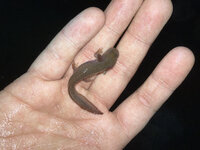Arkansas’s salamanders vary greatly in adult body size and body proportions, ranging from the slender and diminutive dwarf salamander (
Eurycea quadridigitata), which as an adult rarely exceeds three inches in total length and is found in the southern regions of the state, to the elongated three-toed amphiuma (
Amphiuma tridactylum), which can grow to over three feet and is found mostly in the Delta. The Ozark hellbender (
Cryptobranchus alleganiensis), a large aquatic salamander, has a robust body form and has a very limited distribution in several northern counties, whereas the western lesser siren (
Siren intermedia) has a tube-shaped slender body similar to that of the three-toed amphiuma. It occurs primarily in the eastern and southern regions of the state. Four Arkansas salamanders are permanently aquatic: the Ozark hellbender, the three-toed amphiuma, the Red River mudpuppy (
Necturus maculosus), and the western lesser siren. The latter two of these possess permanent fleshy external gills. A number of Arkansas’s species are semi-aquatic and dwell in or around the shorelines of creeks and small streams, along springs and in springheads, and in caves. One such species is the colorful cave salamander (
Eurycea lucifuga), which has a reddish orange back with small black spots. It occurs north of the
Arkansas River in the
Ozarks. Another is the Ouachita dusky salamander (
Desmognathus brimleyorum), which occurs primarily in the mountainous southwestern counties south of the Arkansas River. Local residents in the Ozark and
Ouachita mountains sometimes mistake lizards, which are reptiles, for salamanders (or vice versa), often referring to the latter as “spring lizards.”
Some of the more commonly observed woodland salamanders are surface or near-the-surface dwellers. They occur in and under logs or beneath large rocks and boulders. The Ozark zig-zag salamander (
Plethodon angusticlavius) and the western slimy salamander (
Plethodon albagula) are two excellent examples. The former occurs only in the
Ozark Mountains, whereas the latter is found throughout the Interior Highlands. What is most interesting about these two species and other members of the genus
Plethodon is that they are lungless; oxygen-carbon dioxide exchange for respiration occurs solely through their skin and oral cavities.
Internal fertilization is the rule in nearly all Arkansas salamanders except the primitive Ozark hellbender and the unusual western lesser siren, which has no internal cloacal glands specifically related to reproduction. In Ozark hellbenders, external fertilization is similar to the method employed by fish; i.e., males spew milt onto eggs previously laid by females. The nesting chamber is commonly beneath a large riverine boulder or within a secluded crevice or rock cluster in a stream. Very little is known about actual egg-laying/courtship in Ozark hellbenders or about the breeding biology in the western lesser siren.
For those species that engage in internal fertilization, a somewhat elaborate courtship display involves the male depositing a sperm packet (spermatophore) onto the substrate (pond bottom in aquatic-breeding salamanders and terrestrial surface in other forms). He then leads the female into a position where her vent (anal region) hovers precisely over the spermatophore. She will then pick up the top of the spermatophore that contains the sperm with her cloacal lips. The sperm eventually move into sperm receptacle glands embedded inside the female’s cloaca. Here the sperm remain until fertilization occurs during egg laying. Females may retain sperm for several days to several weeks and sometimes several months.
In 2014, a new salamander species was discovered in Arkansas. The new species is a small, larviform paedomorph commonly known as the
Ouachita streambed salamander (
Eurycea subfluvicola). It has a highly restricted distribution, occurring only in a single stream that flows into
Lake Catherine near
Hot Springs (Garland County). At present, little is known about its life history or population size.

